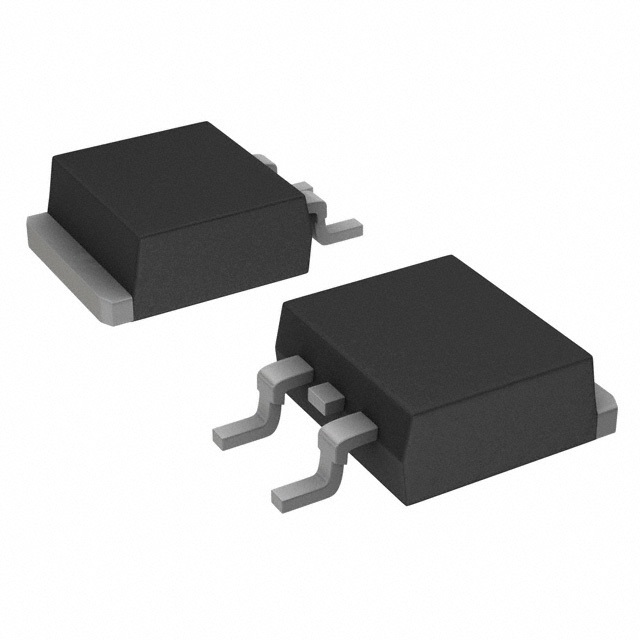Lihat spesifikasi untuk detail produk.

FQB2N80TM - Product Overview
Introduction
The FQB2N80TM is a power MOSFET belonging to the category of electronic components used in various applications. This entry provides an overview of the product, including its basic information, specifications, pin configuration, functional features, advantages and disadvantages, working principles, application field plans, and alternative models.
Basic Information Overview
- Category: Power MOSFET
- Use: The FQB2N80TM is commonly used in power supply, motor control, and other high-power switching applications.
- Characteristics: It exhibits low on-state resistance, high switching speed, and low gate charge, making it suitable for high-efficiency power conversion.
- Package: The FQB2N80TM is typically available in TO-263 packaging.
- Essence: Its essence lies in providing efficient power switching capabilities.
- Packaging/Quantity: It is usually packaged in reels or tubes, with varying quantities based on manufacturer specifications.
Specifications
- Voltage Rating: 800V
- Current Rating: 2A
- On-State Resistance: 1.6Ω
- Gate Charge: 15nC
- Operating Temperature Range: -55°C to 150°C
- Datasheet: FQB2N80TM Datasheet
Detailed Pin Configuration
The FQB2N80TM typically consists of three pins: Gate (G), Drain (D), and Source (S). The pin configuration is as follows: - Gate (G): Input pin for controlling the switching operation. - Drain (D): Output pin connected to the load. - Source (S): Common pin for the input and output circuits.
Functional Features
- High Efficiency: Due to its low on-state resistance and gate charge, the FQB2N80TM enables high-efficiency power conversion.
- Fast Switching Speed: It offers rapid switching characteristics, reducing switching losses in high-frequency applications.
- Reliability: With its robust design, the MOSFET ensures reliable performance in demanding environments.
Advantages and Disadvantages
Advantages
- High efficiency in power conversion
- Fast switching speed
- Reliable performance in demanding conditions
Disadvantages
- Higher cost compared to standard MOSFETs
- Sensitive to voltage and current spikes
Working Principles
The FQB2N80TM operates based on the principle of field-effect transistors, where the voltage applied to the gate terminal controls the flow of current between the drain and source terminals. By modulating the gate voltage, the MOSFET can efficiently switch high-power loads on and off.
Detailed Application Field Plans
The FQB2N80TM finds extensive use in the following applications: - Power Supplies: Used in high-voltage power supply units for efficient power management. - Motor Control: Employed in motor drive circuits for controlling the speed and direction of motors. - Switching Converters: Integrated into DC-DC converters for high-efficiency power conversion.
Detailed and Complete Alternative Models
Some alternative models to the FQB2N80TM include: - IRF840: A similar power MOSFET with comparable voltage and current ratings. - STP16NF06: Offers similar characteristics and is suitable for power switching applications. - IXFH50N80: An alternative MOSFET with enhanced current-handling capabilities.
In conclusion, the FQB2N80TM power MOSFET serves as a crucial component in various high-power applications, offering high efficiency, fast switching speed, and reliability. Understanding its specifications, functional features, and application field plans is essential for leveraging its capabilities effectively.
[Word Count: 593]
Sebutkan 10 pertanyaan dan jawaban umum terkait penerapan FQB2N80TM dalam solusi teknis
What is FQB2N80TM?
- FQB2N80TM is a power MOSFET transistor designed for various technical applications requiring high voltage and current capabilities.
What are the key specifications of FQB2N80TM?
- FQB2N80TM has a maximum drain-source voltage of 800V, a continuous drain current of 2.4A, and a low on-resistance.
In what technical solutions can FQB2N80TM be used?
- FQB2N80TM is commonly used in power supplies, motor control circuits, lighting systems, and other high-voltage applications.
How does FQB2N80TM contribute to energy efficiency in technical solutions?
- FQB2N80TM's low on-resistance helps minimize power losses and improve overall energy efficiency in high-power applications.
What are the thermal considerations when using FQB2N80TM in technical solutions?
- Proper heat sinking and thermal management are important to ensure that FQB2N80TM operates within its specified temperature range for reliable performance.
Can FQB2N80TM be used in automotive applications?
- Yes, FQB2N80TM can be utilized in automotive systems such as electric vehicle powertrains, battery management, and charging systems.
Are there any application notes or reference designs available for FQB2N80TM?
- Yes, the manufacturer provides application notes and reference designs to assist engineers in implementing FQB2N80TM in various technical solutions.
What protection features does FQB2N80TM offer for circuit safety?
- FQB2N80TM includes built-in protection against overcurrent, overvoltage, and thermal overload to safeguard the connected circuitry.
Can FQB2N80TM be used in switching power converter designs?
- Yes, FQB2N80TM is suitable for use in switching power converters due to its high voltage and current handling capabilities.
Where can I find detailed technical documentation for FQB2N80TM?
- Detailed datasheets, application guides, and technical specifications for FQB2N80TM can be obtained from the manufacturer's website or authorized distributors.

